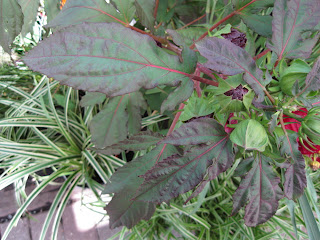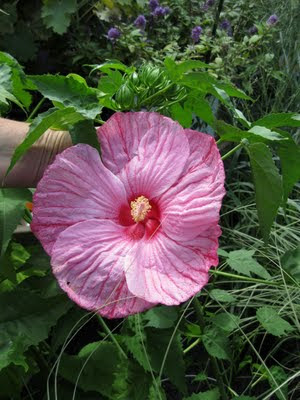 |
| 'Cranberry Crush' |
What many don't realize, though, is that there's a hardy perennial version that blooms from this time of year until frost. Its large flowers are a welcome addition to the garden at a time when few other plants are still providing color.
That is especially true this year when our extensive stretch of 100-degree weather prompted many long-blooming plants to stop earlier than usual. Heat exhaustion, I guess.
Hardy hibiscus flowers can be very large, 8 to 12 inches across, and the plants need to be staked as a result. Some people unfortunately avoid them as a result and that's a shame. The plant has come a long way in recent years and are worthy of a second look.
Initially, hibiscus moscheutos only came in red, pink or white and had rounded leaves like hollyhocks, another member of the mallow family. The latest hybrids come in a broader array of colors and have much more intersting leaves that provide year-round interest.
 |
| The leaves of 'Cranberry Crush' |
And then there's Blue River II, which despite its name, has the purest white flowers you've ever seen. It would be fantastic in a moon garden.
 |
| 'Blue River II' |
Hardy hibiscus are hybrids of native wildflowers, though, and they returned reliably, year after year, even with the cold Minnesota winters. They especially work well with spring bulbs as the bulbs are finished blooming by the time the hibiscus starts growing.
These plants started out in swamps so they like consistent moisture for the first year. But once established, they can withstand drought. They need at least six hours of sun and keep blooming despite sweltering temperatures.
Hardy hibiscus don't have the same insect problems that tropical hibiscus can, although be on the lookout for Japanese beetles. Hibiscus should be cut back after a hard frost to about 12 inches and mulched.
 |
| 'Peppermint Schnapps' |
